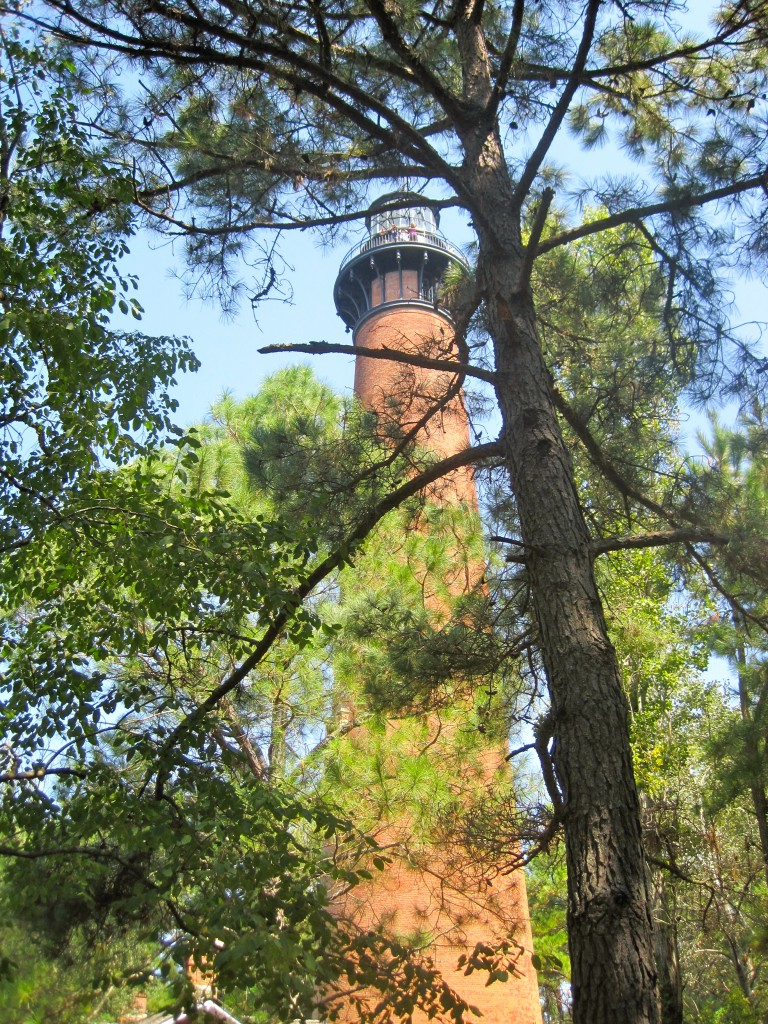Flashes of lightening send the sky into an identity crisis between blinding light and extreme darkness. Rain lends a natural carwash, sounding more like sprinkles meeting the ground after falling from the kitchen cabinet. The mad dash indoors begins. One. Two. Three. Go. This night seems fitting for my first on North Carolina’s Outer Banks.
The Outer Banks of North Carolina stretch from the Virginia state line to Cape Lookout in the south, joined by bridges and ferries. A storm far greater than the one I am in tonight decided to rip through this vulnerable stretch just weeks before my visit. Hurricane Irene would make it impossible to visit Hatteras Island, a large chunk of the Outer Banks. Regardless of Irene’s passing, she still lingers on boards tacked to windows and through debris along the sides of the road. And like the song Goodnight Irene, I bid her goodnight despite her attempts to ruin my plans.
I head on up the coast, to the northernmost beaches of the Outer Banks. The weather has calmed from the previous night. I stop at the Currituck Beach Lighthouse, the only lighthouse I would be able to see along the Outer Banks. Completed in 1875, around one million bricks make up its construction. It is not near the water, serving the purpose of posing for the camera. Unpainted and plain, it might not be the classic black and white lighthouse I envisioned, but there is something much more raw and real about it.
When the sun begins to set on the Outer Banks, the sky’s hues of lavender and light blue are undeniable on the water. Walking down from my neighborly inn, the kind where all guests want to chat over morning coffee, I plop down on the sand and admire the beach in Kill Devil Hills.
Despite the kitsch of Kill Devil Hills, Kitty Hawk and Nags Head, there are subtle moments where you don’t mind all of the color and glitz. Walking back from my sunset on the water, I find the most colorful of lumber. The light in the Outer Banks cultivates this color, something you can’t quite place until you see it.
Having to head back inland to see the Lower Outer Banks due to Hurricane Irene’s damage, I make a brief stop on Roanoke Island. The island was the site of the first permanent English settlement in the New World. However, when a ship returned to see how the settlement was doing, bringing supplies and the like, the colony had vanished without a trace. A thought that has baffled historians, they still don’t know what happened, but I think I might. On an attempt to visit the Fort Raleigh National Historic Site where supposed traces of this lost colony can be seen, mosquitoes attack, sending me running back to my car. Mosquitoes the size of large flies drove me mad. I imagine the settlers of the Lost Colony would have felt the same. Mystery solved history.
Ten bites later and a few more hours, I find myself on the Lower Outer Banks, near the Cape Lookout National Seashore. I take a boat out to Shackleford Banks. This is the barrier island home to over a hundred wild horses, thought to be descendants of a Spanish shipwreck. Stepping onto this island of sand, I realize I haven’t been somewhere like this before. Shackleford Banks lacks amenities or any sort of towns. Many have tried to live here, but storms drove them out. The captain explains how the Banks have moved around 50 yards due to Irene. Everyone is affected, even the wild horses.
Most come to Shackleford Banks to see the wild horses, hundreds of years old in origin. My search turns up empty. I don’t see one, just the hoof prints in the sand. I guess they are here somewhere. Others come to collect seashells. So many are completely perfect in shape, it is hard to pick just one to take home.
Heading back inland, Carrot Island is dotted with some horses. These however are not famous like the Shackleford Banks creatures. They have only been on the island for 60 years, but they are remarkable just the same.
Irene may have spoiled my visions to some degree of the Outer Banks. A place so peaceful and calm now, it’s hard to imagine the area any other way. The hurricanes can roll through, but they can’t take the indescribable light the Outer Banks possesses.










My heart leaped a little when I saw your tweet. I’ve only been to the Outer Banks once, but utterly fell in love with them. Even, as you say, the parts which are quite touristy very much have their upsides too. I’ve been wondering how they fared after Irene. It isn’t somewhere which makes many headlines here. I ended up in Okracoke, which, if I could live anywhere in the world is where I would choose! Quite remote and peaceful, yet it seems to attract interesting and intelligent folk to live there. Love your pictures!
How beautiful. The pictures look so serene & inviting, I can’t imagine them any other way either. But such is nature, it lures us and sometimes, it destroys us.
I chuckled at the mystery that solved history. Wonder what really happened to them though. Sounds like the Bermuda Triangle story in many ways.
Lovely use of words as always, Suzy 🙂
glad to see the outer banks remain as beautiful as before hurricane irene. i spent every summer there when i was younger! xx, the wino